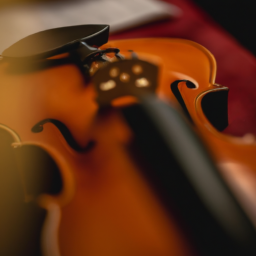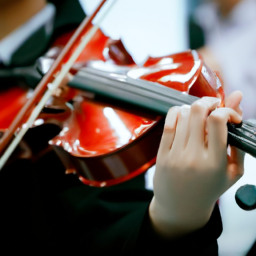
Learning to play the violin as a beginner can be an exciting and rewarding journey. The violin is a beautiful instrument that has captivated audiences for centuries. However, like any new skill, it requires dedication, practice, and guidance to master.

Understanding the dos and don'ts of learning to play the violin is crucial for effective progress and avoiding common pitfalls. In this article, we will explore the essential tips and practices that every beginner violinist should know. Whether you're starting from scratch or have already begun your violin journey, these dos and don'ts will help you navigate the learning process with confidence and success.

One of the most important dos of learning to play the violin is to seek professional instruction. Having a qualified violin teacher can make a significant difference in your progress and overall learning experience.

A skilled violin teacher will not only teach you proper technique but also provide personalized guidance tailored to your specific needs and goals. They will help you develop a solid foundation, correct any bad habits, and guide you through the different stages of learning.

Furthermore, a violin teacher will ensure that you are using the correct posture, hand positioning, and bowing technique. Learning these fundamental aspects from an expert will save you time and prevent future difficulties or injuries.
While it may be tempting to jump straight into playing your favorite melodies, skipping the basics is a common mistake that beginners make. Learning and practicing basic violin techniques are essential for building a strong foundation and setting yourself up for success.
Some of the essential skills that beginners should focus on include proper bow hold, finger placement, and bowing technique. These fundamental techniques may seem tedious at first, but they lay the groundwork for more advanced playing in the future.
Instead of rushing through these basics, take your time to master them. Practice scales, exercises, and simple tunes to develop muscle memory and improve your overall playing ability.
Consistent practice is key to progress and improvement when learning to play the violin. Set aside dedicated time each day to practice and make it a part of your routine.
Regular practice allows you to reinforce what you've learned, develop muscle memory, and build stamina. It is better to practice for shorter periods every day than to have longer practice sessions once in a while.
To stay motivated, set specific goals for each practice session and track your progress. Celebrate small victories along the way, and don't get discouraged if you encounter challenges. Remember that learning to play the violin is a journey, and progress takes time.
Learning to play the violin is not a race. It's important to resist the temptation to learn too quickly or take on advanced techniques before you are ready.
Rushing the learning process can lead to frustration, poor technique, and even physical injuries. It's crucial to build a solid foundation by mastering the basics before moving on to more advanced concepts.
Take the time to practice and perfect each technique before moving on to the next. Give yourself permission to make mistakes and learn from them. Remember, slow and steady wins the race when it comes to learning the violin.
Before you start playing the violin, it's essential to warm up and stretch your muscles. Warming up helps prevent injuries and prepares your body for playing.
Start with gentle stretching exercises for your neck, shoulders, arms, and fingers. This will increase blood flow and flexibility, allowing you to play with more ease and comfort.
Additionally, warming up with a few minutes of bowing exercises and scales can help improve your tone and control. It's like stretching before a workout - it prepares your body and mind for optimal performance.
Proper posture is crucial for efficient and comfortable violin playing. Neglecting posture and ergonomics can lead to tension, discomfort, and even injuries.
When playing the violin, sit or stand up straight with your shoulders relaxed. Keep your head up and avoid slouching. Place your feet firmly on the ground if you are sitting, or use a footstool if you prefer to play while standing.
Position the violin on your collarbone, with the chinrest supporting your jaw. Avoid gripping the violin too tightly with your chin, as this can cause strain and restrict your movement.
Remember to take regular breaks during practice sessions to relieve any tension or stiffness. Paying attention to your posture and ergonomics will greatly enhance your playing experience and prevent discomfort.
Listening to professional violinists and recordings is an excellent way to enhance your musicality and inspire your own playing.
Immerse yourself in a variety of violin music, from classical to contemporary, and listen to different styles and interpretations. Pay attention to the tone, phrasing, and expression of the violinists.
Listening actively can help you develop a deeper understanding of the violin's sound and possibilities. It can also spark your creativity and provide ideas for your own playing.
Comparing your progress to that of others can be detrimental to your learning journey. Each violinist progresses at their own pace, and it's essential to focus on your individual growth rather than constantly comparing yourself to others.
Celebrate your own achievements, no matter how small they may seem. Learning to play the violin is a personal journey, and every step forward is a significant accomplishment. Embrace your unique path and stay committed to your own improvement.
Correct hand and finger positioning are crucial for producing a good sound on the violin. Pay attention to the placement of your fingers on the fingerboard and the curvature of your hand.
When placing your fingers on the fingerboard, aim for a rounded shape with your fingertips pressing down on the strings. Avoid collapsing your hand or squeezing the neck of the violin too tightly.
Practice placing your fingers accurately, and make sure to lift them high enough to avoid accidentally touching neighboring strings. Developing proper hand and finger positioning will greatly contribute to your overall sound quality and intonation.
Bow control is a fundamental aspect of playing the violin. It determines the tone, dynamics, and expressiveness of your playing.
When holding the bow, maintain a relaxed grip and allow your fingers to curve naturally around the bow. Practice various bowing techniques, such as long bows, staccato, and spiccato, to develop control and precision.
Experiment with different bowing speeds, pressure, and contact points on the strings to achieve different sounds and effects. Developing bowing skills takes time and patience, so don't overlook this crucial aspect of violin playing.
Learning to play the violin should be an enjoyable and fulfilling experience. While it may require hard work and dedication, it's important to find joy in the process.
Explore different styles of music that interest you and experiment with your playing. Play songs that bring you happiness and allow yourself to express your emotions through the violin.
Join a community orchestra or ensemble to connect with fellow musicians and share your love for the violin. Remember that music is a universal language that brings people together.
Q: How long does it take to learn to play the violin?
A: Learning to play the violin is a lifelong journey. It takes time and consistent practice to develop the necessary skills and techniques. The rate of progress varies for each individual, so it's important to stay committed and patient.
Q: Do I need to learn to read sheet music to play the violin?
A: While reading sheet music is not a requirement, it is highly recommended for violinists. Learning to read music opens up a world of possibilities and allows you to explore a vast repertoire of violin music.
Q: Can I teach myself to play the violin?
A: While it is possible to teach yourself the basics of the violin, having a qualified teacher is highly beneficial. A teacher can provide guidance, correct mistakes, and help you progress more efficiently. They also offer valuable feedback and personalized instruction.
Learning to play the violin as a beginner is a rewarding and fulfilling pursuit. By following the dos and don'ts outlined in this article, you can set yourself up for success and enjoy the journey.
Remember to seek professional instruction, practice regularly, and focus on developing a solid foundation. Embrace the process, listen to violin music, and avoid comparing yourself to others.
By using proper hand and finger positioning, mastering bow control, and enjoying the process, you can become a skilled violinist. Stay committed, seek guidance when needed, and most importantly, have fun playing the violin!
Learn more about violin lessons.